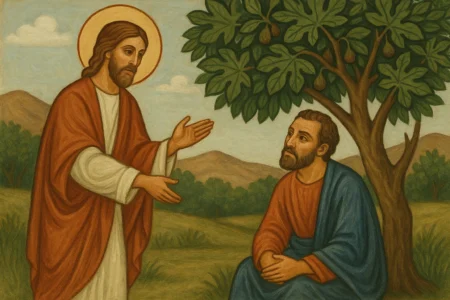When my wife and I were expecting our first son, we agonized over his name. We wrote lists. We debated middle names. We scoured Google for meanings until our eyes blurred. A name just felt so permanent, so foundational to who he would be. In our world, we pour all this effort into a name before we even know the person.
But in the ancient world, it was often the other way around. A name wasn’t just a label. It was a description of your very essence, your character, or your destiny.
That whole obsession with “what a name means” is the perfect backdrop for one of the most pivotal, yet brief, encounters in the New Testament. A gritty fisherman named Simon, son of John, gets dragged along by his brother to meet an itinerant preacher. He probably rolled his eyes. He probably just wanted to get back to his nets. He walks up, and before he can even say “hello,” the preacher looks straight through him and slaps a new name on him.
This one tiny moment, captured in a single verse, sets the stage for the entire future of the Christian church. But why? Why the immediate name change? What did Jesus see in this rough-edged fisherman that made him instantly rename him “Rock”?
This isn’t just trivia. Understanding this moment is critical. So, this article is my deep-dive, a “John 1:42 Explained” for the rest of us. We’re going to pull apart the theology, the prophecy, and the simple, human power of being truly seen.
More in John Chapter 1 Category
Key Takeaways
- The Verse: John 1:42 records the very first meeting between Jesus and Simon. Jesus immediately renames him “Cephas” (Aramaic) which John’s Gospel translates to “Peter” (Greek).
- The Meaning: Both “Cephas” and “Peter” mean “rock” or “stone.”
- The Prophecy: This name change was a prophetic declaration. Jesus wasn’t describing Simon’s current personality (which was impulsive and unstable) but declaring his future destiny and character.
- The Transformation: The name “Simon” (meaning “he has heard”) represented his old, natural self. The new name “Peter” signified his new identity and divine calling as a foundational leader.
- The Fulfillment: This new name, Peter, directly foreshadows Jesus’s famous statement in Matthew 16:18: “…on this rock I will build my church.”
- The Theme: The entire event powerfully illustrates a core theme of the Gospel: Jesus sees us not for who we are, but for who He is making us to be.
Who Was Simon Before He Became Peter?
So, let’s get a clear picture of the man. Before he was St. Peter, he was just Simon. Or, more formally, Shimon bar-Yonah (Simon, son of Jonah or John).
He was a fisherman from Bethsaida, a town on the shore of the Sea of Galilee. This was not a desk job. This was a grueling, physically demanding, calloused-hands-and-sun-scorched-neck kind of life. He and his brother Andrew were partners with James and John, the sons of Zebedee. They were blue-collar entrepreneurs, running a small business in a tough market under the thumb of Roman occupation.
He was a married man (we know this because Jesus later heals his mother-in-law). He was devout enough to follow John the Baptist, or at least his brother Andrew was, which is how this whole thing starts.
But here’s the kicker: from what we see later in the Gospels, he was a man of staggering contradictions. He was all heart, all passion. He was impulsive. He was fiercely loyal one minute and shockingly cowardly the next. He was the one who would leap out of the boat in a storm and the one who would sink like a… well, a stone.
He was, in other words, a total human. A reactor. A man of big emotions. He was anything but a rock.
Was Simon’s Original Name… Bad?
It’s a fair question. Did Jesus change his name because “Simon” was a bad name?
Absolutely not. “Simon” (from the Hebrew Shimon) was a wonderful, historic, and very common Jewish name. It means “he has heard” or “hearing.” The original Simon was one of the twelve sons of Jacob, the patriarch of one of the twelve tribes of Israel. It was a name steeped in covenant history.
So, Jesus wasn’t correcting a bad name. He was assigning a new destiny. He wasn’t erasing Simon’s past. He was giving him a new future. It was a promotion. An ordination. It was a divine calling that would supersede, but not entirely erase, the man he had been.
What Exactly Happens in John 1:42?
Picture the scene. It’s the very beginning of Jesus’s ministry. John the Baptist has just pointed him out, saying, “Behold, the Lamb of God!”
Two of John’s disciples, one of whom is Andrew (Simon’s brother), hear this and immediately start following Jesus. They spend the day with him. This encounter so profoundly rocks Andrew’s world that his first thought is: I have to get Simon.
The text says, “He first found his own brother Simon and said to him, ‘We have found the Messiah’ (which is translated, the Christ).”
This is massive. Andrew is essentially saying, “The one we’ve been waiting for, the one all of prophecy points to… he’s here. I just spent the day with him.” Simon, likely skeptical but pulled along by his brother’s infectious excitement, agrees to go.
Then we get to the verse itself.
“And he brought him to Jesus. Jesus looked at him and said, ‘You are Simon son of John. You will be called Cephas’ (which, when translated, is Peter).”
Now, let that sink in for a second.
Jesus doesn’t say, “Hi, nice to meet you.” He doesn’t make small talk about the fishing business. He doesn’t even wait for an introduction.
He looks at him.
This isn’t a casual glance. The Greek word here is emblepsas, which implies a deep, penetrating gaze. A look that sees everything. I’ve felt a look like that from a mentor before, a look that seemed to understand all my fears and all my potential in a single second. It’s unnerving. And in this moment, Jesus looks at this fisherman and, in essence, says:
“I know who you are. You are Simon, son of John. But I know who you will be. You will be Kepha.”
Why Did Jesus Choose the Name “Cephas” (or Peter)?
This is the real heart of the matter, the core of “John 1:42” Why “rock”?
Let’s start with the language. Jesus spoke Aramaic, the common language of the people. The Aramaic word for “rock” is Kepha. This is what Jesus would have said. John, writing his Gospel decades later in Greek for a wider audience, translated it. The Greek word for “rock” is Petros.
So, Cephas = Kepha = Petros = Peter = Rock. They all mean the same thing.
But here’s the thing: this name is just dripping with irony. He chose the most unstable, impulsive, emotionally volatile man in the group and called him “Rock.”
Why?
Because Jesus wasn’t naming Simon’s character. He was declaring his calling. He was speaking to the finished product, not the raw material.
But Wasn’t Simon… Unstable?
He absolutely was. This is the man who, just a short time later, would:
- See Jesus walking on water and impulsively jump out of the boat (Matthew 14).
- Immediately begin to sink because he took his eyes off Jesus.
- Try to rebuke Jesus for predicting his own death (Matthew 16).
- Draw a sword in the Garden of Gethsemane and cut off a servant’s ear (John 18).
- Swear up and down that he would never deny Jesus.
- …and then, just hours later, deny three times that he even knew the man (John 18).
This is not “rock-like” behavior. This is “shifting sand” behavior. This is “loose gravel” behavior.
I had a football coach in high school, a tough-as-nails guy. I was a scrawny, nervous sophomore, and I fumbled everything in practice. One day, he started calling me “Steady.” It was a complete joke. “Hey, Steady, try holding onto the ball this time!” But a funny thing happened. He kept calling me that. And over time, I started focusing on being steady. I wanted to live up to the name, even a sarcastic one. His words, in a weird way, reshaped my focus.
Jesus is doing something infinitely more profound. He’s not being sarcastic. He’s being prophetic. He is calling things that are not as though they were. He’s looking at the fumbling, impulsive fisherman and speaking a new reality into existence. He’s placing the mantle of “stability” on the most unstable man.
So, Was This Name a Nickname or a Prophecy?
It was 100% a prophecy. And like all good prophecies, it had a fulfillment.
The name change in John 1:42 is Act One. It’s the setup. Act Two, the climax of this entire “Peter” narrative, comes much later, in Matthew 16.
You know the scene. Jesus takes his disciples to Caesarea Philippi and asks them the most important question in the world: “Who do you say that I am?”
The disciples hem and haw. “Some say John the Baptist… others Elijah…”
Then, Simon Peter, the impulsive one, speaks up. But this time, his impulsiveness is guided by divine revelation. “You are the Messiah,” he declares, “the Son of the living God.”
This is the great confession. This is the bedrock truth of Christianity. And look at Jesus’s response:
“Blessed are you, Simon son of Jonah… And I tell you, you are Peter (Petros), and on this rock (petra) I will build my church, and the gates of Hades will not overcome it.”
This is the big “Aha!” moment. Jesus essentially says, “Bingo! This is why I called you ‘Rock.’ Your old man, Simon, didn’t figure this out. This truth was revealed to you by my Father. And you, Peter, the man you are becoming, the man who speaks this foundational truth… you are the rock I’m building on.”
The name given in John 1:42 was a seed. The confession in Matthew 16 is the first fruit.
What’s the Difference Between Petros and Petra?
Alright, if you want to get really nerdy—and this part is fascinating—it comes down to two Greek words.
In Matthew 16:18, Jesus uses two different (but related) Greek words:
- Petros (masculine): “You are Petros…” This is Peter’s name. It means a stone, or a piece of rock.
- Petra (feminine): “…and on this petra I will build my church.” This means a large rock mass, a cliff, or bedrock.
For 2,000 years, theologians have debated what “this rock” (petra) refers to.
Does This Mean the Church Was Built on Peter or His Confession?
This is a central point of division between Catholic and Protestant theology, and it all hinges on that name change.
- The Catholic interpretation is that Jesus is making a play on words, but the meaning is clear: the Church is built on the person of Peter (Petros). He is the petra. He is the first Pope, the rock-like foundation, the leader given the “keys to the kingdom.” The name change in John 1:42 was Jesus’s first step in establishing this new office.
- The Protestant interpretation argues the distinction is crucial. Jesus is not saying he will build the church on the man, Peter (Petros), who was fallible and prone to sinking. He is saying he will build the church on the great confession that Peter just made—the petra, the bedrock truth that Jesus is the Son of God.
My personal take? I think it’s a beautiful “both/and.” The church is, of course, built on the truth of Christ’s divinity. But that truth must be proclaimed by people. Jesus chose Peter, the man He transformed from sand to stone, to be the first to make this confession and to be the foundational leader (a rock) for the new community.
The name change in John 1:42 is the beginning of that transformation. Jesus was forging the man who would be strong enough to make the confession and lead the church.
What Can We Learn From This Name Change Today?
Okay, so what does this mean for us, right here, right now? This “John 1:42 Explained” isn’t just for a history lesson. It’s a model for our own lives.
Does Jesus See Our Potential, Not Just Our Past?
Jesus looked at Simon and didn’t just see the fisherman. He didn’t see the future denial. He saw the future preacher of Pentecost. He saw the “rock” who would “strengthen his brothers.” He saw the martyr who would be crucified upside down, feeling unworthy to die in the same manner as his Lord.
He saw the finished product.
I can be so hard on myself. My wife still gently points out my “Simon moments,” like when I get a brilliant-but-terrible idea at 10 PM and want to start a new project right now. I see my failures, my impulsiveness, my “Simon” nature, all too clearly.
But the radical hope of John 1:42 is that Jesus doesn’t see us that way. He looks at us in our “Simon” state and calls us by our “Peter” name. He sees the potential He poured into us. He sees who we are in Him.
That is incredibly freeing. Your identity is not defined by your worst mistake or your most impulsive decision. Your true identity is the new name He speaks over you.
Where Do We Find Our New Identity?
Simon’s identity was “son of John.” He was defined by his lineage. His trade. His past. His new identity was “Peter.” He was defined by his calling. His future. His Lord.
The encounter with Jesus was a re-defining moment. And it’s the same for anyone who follows him. The old name, the old identity—”worrier,” “addict,” “failure,” “unloved”—is replaced by a new one. “Child of God.” “Redeemed.” “Beloved.” “Rock.”
This is why the name change had to happen first. Before any teaching, any miracles, any ministry. The very first order of business was to establish Simon’s new identity. “You’re not who you think you are. You’re who I say you are.”
But Why Did Jesus Still Call Him “Simon” Sometimes?
This is a fantastic question, and the answer is one of the most beautiful parts of the whole story. The name “Peter” sticks, but it doesn’t completely replace “Simon.” Jesus uses both. And when he uses each name is incredibly significant.
He often calls him “Peter” when he’s acting in his new, apostolic authority (like in Matthew 16).
But he often reverts to “Simon” in moments of intimate correction or before a great test.
My absolute favorite example is at the Last Supper (Luke 22:31-32). Jesus looks at him and says, “Simon, Simon, Satan has asked to sift all of you as wheat. But I have prayed for you, Simon, that your faith may not fail. And when you have turned back, strengthen your brothers.”
Notice that. He’s about to face his greatest failure—the denial. His “Simon” nature is about to be on full display. Jesus calls him “Simon” four times. It’s like he’s saying, “Your humanity is about to be tested, Simon. You’re going to fail. But I’ve prayed for you. And when you return… you will fulfill your ‘Peter’ calling. You will be the rock. You will strengthen your brothers.”
This, right here, shows the reality of our transformation. It’s a process. We live in the tension between our “Simon” nature and our “Peter” identity. But the “Peter” identity, the one Christ gives us, is the one that ultimately wins.
What Did John Want Us to Know by Telling This Story?
John’s Gospel is different from the others. It’s deeply theological. Every story, every detail, is there for a reason. He is relentlessly focused on the question of identity.
Throughout his book, he has Jesus declaring “I AM…” “I AM the Bread of Life.” “I AM the Light of the World.” “I AM the Good Shepherd.” “I AM the Resurrection and the Life.”
John’s Gospel is a book-length answer to the question, “Who is Jesus?”
John doesn’t stick this story in the middle of his book. He puts it in chapter one. That’s intentional. He’s showing that the one who is the great “I AM” is also the one who gets to tell us who we are. The one who is the Word is the one who speaks new realities into existence.
This wasn’t just a nickname. It was an act of creation.
The story of John 1:42 is a seed. It’s a tiny verse, a brief moment. But in that moment, a new destiny was forged. The full, grown tree is what we see on the Day of Pentecost (Acts 2), when “Peter, standing with the eleven,” no longer an impulsive fisherman, no longer a fearful denier, but a rock of faith, stands and preaches the first Christian sermon. Three thousand people were saved.
The transformation was complete.
It all started with a look. “Jesus looked at him…” That same gaze is available to us. It’s a look that sees past all our “Simon-ness” and sees the “Peter” He created us to be. It’s a look that doesn’t just see, it changes. It doesn’t just name, it creates.
The question, then, is not just who Simon Peter was. The question is, who does Jesus say you are?
FAQ – John 1:42 Explained
Why did Jesus choose the name ‘Cephas’ (Peter) for Simon?
Jesus chose the name ‘Cephas’ (Aramaic for ‘rock’) for Simon to symbolize the divine destiny and prophetic future Jesus saw in him, transforming his identity from an impulsive fisherman to a stable, foundational leader for the church.
Was Simon’s original name, ‘Simon,’ considered a bad name?
No, ‘Simon’ was a common and meaningful Jewish name meaning ‘he has heard.’ Jesus did not change Simon’s name because it was bad but to signify a new divine destiny and calling for him.
What does the story of John 1:42 teach us about identity and potential?
The story illustrates that Jesus sees our potential beyond our current traits and failures. He calls us by the new name or identity He gives us, which reflects our divine purpose, regardless of our past or present imperfections.
Why does Jesus sometimes call Simon ‘Simon’ instead of ‘Peter’?
Jesus calls him ‘Simon’ during moments of correction or testing, emphasizing his human nature and the process of transformation. It highlights that our divine identity is a journey from our ‘Simon’ self to our ‘Peter’ calling, which Jesus continually nurtures.





